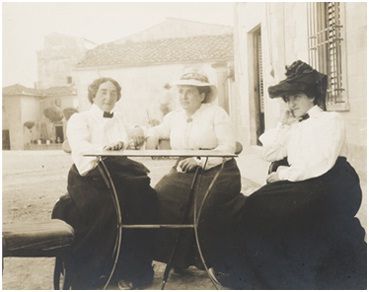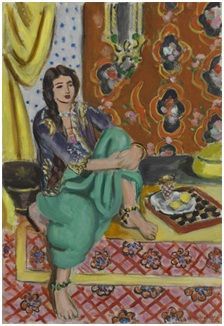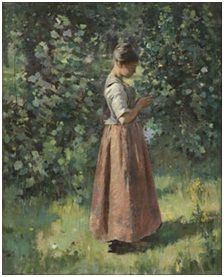Article
A Welcome Diversion: The Cone Sisters of Baltimore
Author(s):
When the stock market is falling and moral fiber seems to be near rock bottom (see Arnold Schwarzenegger and Dominique Kahn-Strauss), it is pleasant to transfer one's thoughts to a subject that is uplifting. This is indeed the case with the current exhibit, "Collecting Matisse and Modern Masters: The Cone Sisters of Baltimore," at the Jewish Museum in New York City.
When the stock market is falling and moral fiber seems to be near rock bottom (see Arnold Schwarzenegger and Dominique Kahn-Strauss), it is pleasant to transfer one’s thoughts to a subject that is uplifting. This is indeed the case with the current exhibit, “Collecting Matisse and Modern Masters: The Cone Sisters of Baltimore,” at the Jewish Museum in New York City.

From the Jewish Museum:
Claribel Cone, Gertrude Stein, and Etta Cone in Settignano, Italy, June 26, 1903
The Baltimore Museum of Art: Dr. Claribel and Miss Etta Cone Papers, Archives and Manuscripts Collection, CG.12.
The two women, shown above on either side of Gertrude Stein, sought pleasure from collecting objects in the early 1900s, successfully and in style. One sister, Claribel, trained to be a physician, though she practiced medicine sparsely. “Claribel preferred objects to people,” according to the museum guide. The other sister, Etta, was a manager of sorts for her extensive family, including 11 brothers and sisters, and their aging parents. Though neither earned money in the usual sense of the term, each selected art that accrued in value outrageously over the years.
Their collection of 3,000 objects, willed to the Baltimore Art Museum in 1949, contained many oils from the painter, Henri Matisse, with whom the sisters had a personal relationship. It also incorporated other important painters of the time, including Picasso, Gauguin, van Gogh and Cézanne. In addition, they purchased textiles and bronzes. Many of these objects from the Baltimore Museum are part of the exhibit in New York City.

From the Jewish Museum:
Henri Matisse (French, 1869—1954)
Seated Odalisque, Left Knee Bent, Ornamental
Background and Checkerboard, 1928
Oil on canvas
21 5/8 x 14 7/8 in. (54.9 x 37.8 cm)
The Baltimore Museum of Art: The Cone Collection,
formed by Dr. Claribel and Miss Etta Cone of
Baltimore, Maryland, BMA 1950.255
© 2011 Succession H. Matisse / Artists Rights
Society (ARS), New York
No purchase records exist for this work.
The sisters were given money by their brother, who was in the textile industry. At one time, the Cone plant was the primary supplier of denim to Levi Strauss & Co. The wealth generated by the company was shared by the family.
The priority placed by the sisters on buying art with their available monies is demonstrated by this story: Etta was given funds to decorate the family home. Instead, she purchased five paintings from the Theodore Robinson estate -- a painter whose work today fetches millions of dollars apiece. These oils were a brilliant choice in retrospect, as were virtually all of the sister’s selections, though their siblings must have been astonished at the time.

From the Jewish Museum:
Theodore Robinson (American, 1852-1896)
In the Grove, c. 1888
Oil on canvas
31 3/4 x 25 3/4 in. (80.7 x 65.4 cm)
The Baltimore Museum of Art: The Cone Collection,
formed by Dr. Claribel and Miss Etta Cone of
Baltimore, Maryland, BMA 1950.291
Purchased by Etta Cone, March 24, 1898.
The sisters had the urge to collect. This is in large part emotional and driven by our pleasure center. The details of its origin and modifying factors are covered in “Why Collectors Collect,” an article I wrote for Fine Art Connoisseur magazine. The sisters were such avid collectors that one of them, Claribel, even purchased a painting on the day she died. It would be her one final contribution to the world -- and a happy one at that.
The exhibit opened on May 6 and runs through Sept. 25, 2011. For those unable to attend, a tour is available on the museum's website with audio additions. It would make an enjoyable addition to any day: Pleasant, educational and inspiring. This is nothing but good when the market and moral fiber are down.




